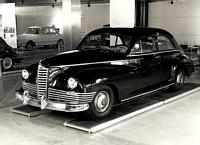COLLECTIBLE PACKARD CLIPPER '42 TO '47

Courtesy www.packard.ws
|
By Bob Hagin
Over the years, I've had lots of cars. Most of them were dull and
simply provided transportation while in retrospect, some of them were
really quite interesting. But their common denominator was that they
didn't cost very much. One of them that very briefly passed through my
hands was a semi-stately Packard Clipper. It was a circa-1946 and well
past its prime when it came into my possession. It had an ominous
bearing rattle in the engine so I passed it on to another buyer as
quickly as possible.
Having spent my pubescent years in the early '40s, I was more
aware of the larger, more stately Packards of the decade before. The
ritzy Piedmont area of Oakland was awash with these carriage-trade
vehicles with bulbous fenders, stand-alone headlights and proper
running boards. These were my early remembrances of the Packard marque.
Obviously, I was too young to know or realize that from a styling
standpoint, those "dignified" Packards were swiftly fading into the
realm of being "dated," a styling stigma in those days of emerging
streamlining and sweeping lines. Our country was still reeling from The
Great Depression and middle-class car buyers wanted modern design that
didn't hark back to the painful experiences of the late '20s. The
somewhat bizarre, but very streamlined Lincoln Zephyr was a hit with
the public and the '40 LaSalle "Baby Cadillac" was a beautiful but
doomed design. Packard management saw the need for change, but
unfortunately its answer to the competition, the Clipper, was just a
few months too early to make its mark in the automotive world.
In early 1940, Packard management contacted Howard "Dutch" Darrin,
an expatriate American auto designer, with an offer. The Packard
vice-president in charge of design told Darrin that his company would
pay him $1000 a day if he could come up with an all-new, modern design
that could immediately be pressed into production. Darrin had returned
to this country in 1937 after a successful career in France designing
and building custom coachwork on expensive European rolling chassis and
was eager for new commissions. He came up with a design within the
prescribed 10-day limit.
Unfortunately, the Darrin design for the new production model
Packard was not accepted, although the final design, put together by a
team of Packard designers, bore an uncanny resemblance to the Darrin
design.
The Clipper made its debut in April of 1941 as a '41 model and it
was offered along side models that carried more traditional Packard
body work. It was a contemporary and totally different design, unlike
any Packard ever made. And while it wasn't in the same upper price
range of the expensive Packard One Sixty behemoth, neither was it a
running mate to the relative low-priced Six, a car that Packard had
parenthetically used as a short-lived entry into the taxi business to
bolster its sales numbers the year before.
The Clipper utilized the traditional Packard tall, arched grille-
work, but unlike its predecessors, the grille was very narrow, with
thin horizontal bars. Its pontoon fenders blended into the body and
swept back into the front doors. The windshield was sharply raked and
the headlights were totally faired into the front fenders. Like the
other mid-sized Packards, it carried a 4.6-liter straight-eight engine
that was more concerned with smoothness than performance. As a new
model, it sold very well during its shortened first sales year and the
production of the 1942 version was well under way with bigger models.
They were offered with longer wheelbases and a gargantuan 5.8-liter
straight-eight engine that was reputed to be capable of easily starting
the car from a dead stop in high gear without a murmur.
But fate was unkind to the Packard Motor Company in general and
its Clipper design in particular. It came out late in the year and at
that time, the traditional model change-over time was October of the
previous year. My Dad was a true auto enthusiast and his idea of a good
time was following the searchlights to the showing of the new Fords,
Chevrolets, Buicks and the rest. By the time April rolled around, the
new car frenzy had died down, although the "all-new" Packard Clipper
was a milestone event for the company. Tooling for the minor changes in
the '42 version must have already been finished when the '41 was
introduced in August of that year.
Three months later, the entire world changed direction on December
7, 1941 when the American economy went to war. Packard produced and
sold 20,000 of its new star before the lid was closed on auto
production for civilians and only a limited number of Clippers were
made for the military as staff cars.
Four years later, the American auto industry girded itself for the
pent-up need for new autos and "old" designs were well received simply
because the cars themselves were new. Although the Clipper had only
been around for a few short months before the war started, it was
already dated when it went into Packard showrooms in October of 1945.
The version that followed in 1948 lacked the style and grace of the
original.
The Clipper I owned was a post-war version (probably a '46) Model
Six four-door sedan, the least expensive Packard available then.
Unfortunately, I didn't appreciate it and since it suffered
considerable rust-out, I'm sure it has long since been relegated to
scrap metal along with the other neo-classics that passed through my hands.
But when I see one that's been restored at a concours or a classic
car meet, I note that the driver always wears a smile. After all, the
Packard motto was "Ask The Man Who Owns One."



